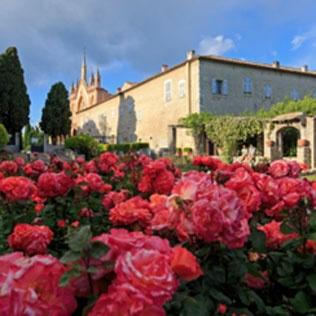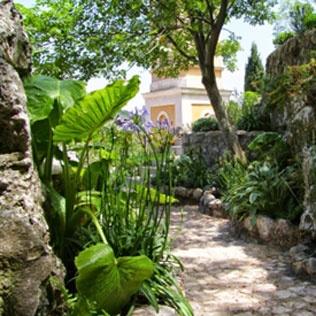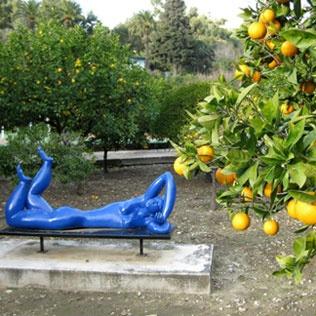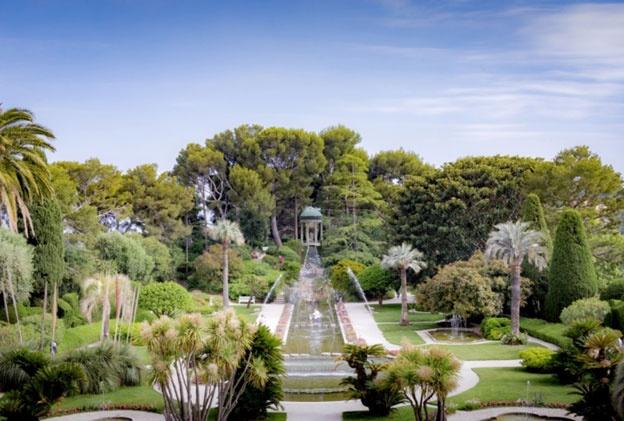Botanical Gardens
Whenever I visit a new place, the local botanical garden is always one of my first stops. The south of France is home to many beautiful botanical gardens and green spaces, each with a unique vibe, from small tucked-away gardens to manicured parks.
As you follow winding pathways and admire vibrant flowers, you can’t help but marvel at the beauty of it all. The sun-drenched flowers send fragrant whispers through the air as the soft Mediterranean breezes sweep through them. Wandering through the garden, one can take in all of its wonders, from aromatic herbs to wild mushrooms or vivid orchids to delicate lilies. Gardens are magical places; the South of France has many you will never forget.
Parc Phoenix
As you enter the park, you are immediately greeted by a large lake, which pelicans, ducks, and swans call home. Just beyond the lake, a fountain dances along to classical music and a large grassy picnic area and café to supply the treats for your picnic.
The 2,500 species of plants are spread throughout different gardens, themed to appeal to all visitors. History fans will find the “Island of Bygone Times,” which features species that have survived over eight million years, fascinating. The Provençal area has a traditional Provençal “cabanon” with cypress and olive trees, which have been synonymous with Mediterranean countries since they were introduced over 3,000 years ago. A “Northern Embankment Trail” recreates a Californian sequoia forest – though the trees are understandably smaller – and includes a monument to U.S. President Teddy Rosevelt, who established American National Parks inspired by the Giant Sequoias the trail emulates. Parc Phoenix also has a bamboo grove, vegetable garden, and sage garden, all beautifully and uniquely designed.
The primary greenhouse in Parc Phoenix, known as the “Green Diamond,” is one of the largest in Europe. As you enter, tropical air fills your lungs as the greenhouse is divided into six tropical and subtropical climates. Butterflies flutter around the tropical plants as exotic fish, and flamingos fill the greenhouse’s waterway.
Within the park, you’ll also find the Museum of Asian Art and a zoo, both included in the park’s ticket price. The Museum of Asian Art thoughtfully designed building sits over the lake. The permanent collections house art from China, Japan, and India, while the rotating exhibitions highlight various practices and cultures from multiple Asian countries, like Palace Paradise’s exploration of a Taiwanese funerary tradition. These exhibitions also include workshops and activities, such as a linocut printmaking workshop in collaboration with the Tatouages du Monde Flottant exhibition of Japanese tattooing history.
Part of the park’s zoo surrounds the greenhouse, some animals roam freely throughout the park, and even more enclosures are spread throughout the grounds, including a small farm featuring a miniature horse, dwarf goats, dwarf pigs, and dwarf rabbits.
Walking around Parc Phoenix, you’ll find a satisfying diversity of flora, fauna, and activities, letting visitors be led by their curiosity from one exhibit to the next.
Parc Phoenix is open all year except for New Years and Christmas. Entrance is 5 euros for adults, 3 euros with the Museum Pass, and free for children under twelve. Special and seasonal events are geared towards children, like swimming lessons, a student triathlon, health and sports workshops, a bee festival, and a Halloween party.

Jardin du Monastere de Cimiez
While the Monastere de Cimiez is worth the visit on its own – with gorgeous murals, art exhibits, and a museum – the gardens are a must-see for any botanical lover. Due partly to its connection to the monastery, the gardens offer peace and tranquility, making this a popular spot among locals seeking respite from the city’s hustle and bustle. The oldest garden in Nice, founded in 1546, Jardin du Monastere de Cimiez, was once a kitchen garden for the adjoining monastery’s monks. Many of its original structures still stand in the untouched layout, including rose-covered pergolas, a fountain, and a pond, all of which have been carefully maintained by the monks. It’s located in the hills of Nice, by the Matisse Museum and Roman amphitheater, allowing panoramic views of the Old City and the Mediterranean from the terrace. The gardens feature local olive, cypress, and citrus trees among gorgeous flowers, but roses are the true star of the show; over 3000 rose bushes fill the flowerbeds, as even more climb up the historic walls and pergolas.

Villa Rothschild
Beatrice Rothschild created the eight beautiful gardens surrounding her villa inspired by memories of her sailing around the world. A diamond of the “Belle Epoque,” the villa and expansive gardens have become an icon of the French Riviera. The themed gardens all connect, leading visitors up and down the hillside into tucked-away corners and onto balconies with incredible views, which anyone could spend hours exploring.
The French Garden keeps the boat theme, designed like a ship deck from Europe’s golden era. It is the largest of the gardens, and the reflecting pool (with dancing water shows) leads right up to the grand villa. Stepping stones where many of my childhood photos were taken are placed throughout the pool, inviting visitors of all ages to hop from one to the other or get a closer look at the fish in the water. A “temple of love” at the top of the hill provides stunning views, with a waterfall feeding into the reflecting pool.
The Spanish or Andalusian Garden displays waterlilies and other colorful, fragrant plants along a canal. Towards one end, you’ll find a small hidden cave to explore, while the other has pergolas drenched in flowers over the canal.
The Florentine Garden was inspired, of course, by the classical era of Florence. It features an elegant staircase from the French Garden to a gorgeous terrace facing the harbor.
The Lapidary Garden is tucked away in the shade, filled with original sculptures and reliefs from the Middle Ages and Renaissance, and a wrought iron well. Azaleas creep up the walls in springtime, with blooming solandras, camellias, and rhododendrons, make spring the ideal time to visit. The lush overhanging plants and art transport you to a forest in a romantic old world.
In the Japanese Garden, beautiful bridges will transport you across tranquil ponds and flowing water. Beautiful stones arranged in white sand and gorgeous greenery enhance the serene energy, especially next to the garden’s koi pond.
An Exotic Garden full of giant succulents and cacti covers a portion of the hill. The paths wind with a bit more freedom here, playing to the garden’s adventurous feel. Aloe and agave plants cover the garden, recreating a wonderfully foreign environment in the South of France.
The Provencal Garden, on the other hand, feels right at home. Olive trees line the quintessential fields of lavender, providing visions of hazy greens and purples that have come to represent the region.
Roses are particularly important to the villa, which hosts the Rose Festival each spring. You’ll find a small “temple” with a statue atop the hill farthest from the villa. Surrounded by hundreds of varieties of roses – one of which is named after Beatrice Rothschild – with gorgeous columns throughout, anyone would feel as if they were walking through a romantic film.
Make your visit to the villa and gardens even more special by taking advantage of one of their “late opening” packages!

Le Jardin Exotique d’Eze
At the top of the historic village of Eze, an ancient fortress houses the award-winning Jardin Exotique d’Eze. The garden is divided into two sections, one dedicated to succulents and drier climate plants, while the other focuses on a more Mediterranean atmosphere. The garden’s paths wind around stunning plants and sculptures by Jean-Phillipe Richard, sprinkled along the way with information about the village’s artistic and historical heritage. A recently added waterfall heightens the otherworldly feeling that Eze is sure to conjure. The journey up the village to the garden, which sits 429 meters above sea level, rewards you with panoramic views of the Cote d’Azur. The village and its garden are well worth the climb.

Jardin d’Agrumes des Pailais Carnoles
Jardin d'Agrumes des Palais Carnoles is a garden worth visiting for any fan of citrus. The gardens are home to a wide variety of citrus trees, including kumquat, mandarin, tangerine, lemon, grapefruit, and many more. Each tree is carefully tended, providing visitors with the experience of a vibrant orchard in full bloom. A dreamy citrus aroma from the garden will embrace any visitor. The garden boasts an impressive collection of citrus fruits from all over the world, including the peculiar "Citrus bizzaria" and blood oranges from the Maghreb region. The Carnolès garden is an oasis of peace and serenity surrounding the palace Prince Honoré II built in the 17th century, while also serving as a source of inspiration for scientists and art enthusiasts alike. The garden's modern objective is to create one of Europe's largest collections of citrus fruits in this garden, while the Palace is home to the Museum of Fine Arts. One can discover tranquility while strolling through the gardens and admiring the vibrant citrus fruits growing here.
